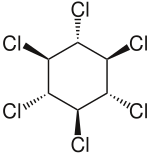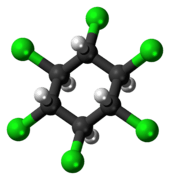beta-Hexachlorocyclohexane
β-Hexachlorocyclohexane (β-HCH) is an organochloride which is one of the isomers of hexachlorocyclohexane (HCH).[1] It is a byproduct of the production of the insecticide lindane (γ-HCH). It is typically constitutes 5–14% of technical grade lindane,[2] though it has not been produced or used in the United States since 1985.[1] As of 2009, the Stockholm Convention on Persistent Organic Pollutants classified α-hexachlorocyclohexane and β-HCH as persistent organic pollutants (POPs), due to the chemical's ability to persist in the environment, bioaccumulative, biomagnifying, and long-range transport capacity.
 | |
 | |
| Names | |
|---|---|
| IUPAC name
β-1,2,3,4,5,6-hexachlorocyclohexane | |
| Other names
β-HCH β-Benzenehexachloride β-BHC | |
| Identifiers | |
CAS Number |
|
3D model (JSmol) |
|
Beilstein Reference |
1907338 |
| ChEBI | |
| ChEMBL | |
| ChemSpider | |
| ECHA InfoCard | 100.005.703 |
| EC Number |
|
| KEGG | |
CompTox Dashboard (EPA) |
|
InChI
| |
SMILES
| |
| Properties | |
Chemical formula |
C6H6Cl6 |
| Molar mass | 290.83 g/mol |
Except where otherwise noted, data are given for materials in their standard state (at 25 °C [77 °F], 100 kPa). | |
| Infobox references | |
This pesticide was widely used during the 1960s and 1970s, particularly on cotton plants. Although banned as a pesticide more than 30 years ago, traces of beta-HCH can still be found in water and soil. Animal studies show that organochlorine pesticides, including beta-HCH, are neurotoxic, cause oxidative stress, and damage the brain's dopaminergic system. Human studies show that exposure to beta-HCH is linked to Parkinson's and Alzheimer's disease.[3] β-HCH was present in elevated levels in some patients as recently as 2009. It was manufactured by exhausting chlorination of benzene and for this reason was called erroneously β-BHC. This synonym still persists.
In March 2005, the Italian National Monitoring System on Chemical Residuals in Food of Animal Origin detected levels of the pesticide β-HCH that were 20 times higher than the legal limit of 0.003 mg/kg in bulk milk from a dairy farm in the Sacco River valley. β-HCH, a lindane isomer and possible human carcinogen, was subsequently found in milk from several neighboring farms. A study was therefore undertaken to evaluate the extent and risk factors for contamination.[4][5]
See also
References
- Toxicological Profile for Alpha-, Beta-, Gamma-, and Delta-Hexachlorocyclohexane, U.S. Department of Health and Human Services, Agency for Toxic Substances and Disease Registry, August 2005
- beta-hexachlorocyclohexane (Beta HCH) Archived July 20, 2008, at the Wayback Machine, Draft Risk Profile, May 2007
- Medscape Medical News, Pesticide Exposure Linked to Parkinson's, Alzheimer's Disease, July 2009
- Sala M, Caminiti A, Rombolà P, Volpe A, Roffi C, Caperna O, Miceli M, Ubaldi A, Battisti A, Scaramozzino P (2012). "[Beta-hexachlorocyclohexane contamination in dairy farms of the Sacco River Valley, Latium, Italy, 2005. A retrospective cohort study]". Epidemiol Prev (in Italian). 36 (5 Suppl 4): 34–43. PMID 23139187.
- "Valle del Sacco: a poisoned land".